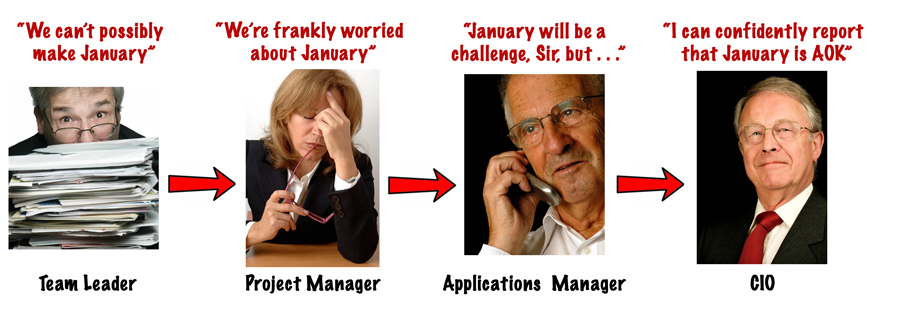45. News Improvement
,
Bad news is not conveyed accurately upward through the organization.
In some organizations, bad news does not get reported upward at all. More often, bad news is improved as it travels upward from one level to the next. Consider the example shown above.
News improvement is a destructive pattern because it deprives decision-makers of needed information, and this can lead to bad decisions (or missed decisions) and outcomes that are worse than they need be. There are many famous examples of bad decisions that could have been avoided had information flowed more effectively. In the last quarter-century, perhaps the decision to launch the space shuttle Challenger on January 28, 1986, is the best illustration of this pattern.
According to author Diane Vaughan in her book The Challenger Launch Decision,1 engineers from Morton-Thiokol recommended against the launch due to concerns about the cold-weather performance of O-ring seals between the sections of the solid rocket motors. After Marshall Space Flight Center officials criticized Thiokol for its recommendation, senior Thiokol managers reversed the recommendation of their engineers and approved the launch. The fact that Thiokol had initially recommended against launching in cold weather was not relayed by the Marshall managers to the senior NASA program manager. The decision to proceed with the launch in unusually cold weather led to the deaths of the crew and the destruction of the spacecraft.
1 Diane Vaughan, The Challenger Launch Decision: Risky Technology, Culture, and Deviance at NASA (Chicago: The University of Chicago Press, 1996).
Thankfully, not all instances of news improvement have such tragic consequences. When you see this pattern in projects, the most typical symptom is surprise, and the typical consequences are missed deadlines and expectations that aren’t met.
Project surprises often follow a story like this: After a few months of development, with successful interim deliverables along the way, the new system is slated for the final round of testing, with shipment in about a month. After a planning session for the last development activities, the project manager reports that an additional month of work will be needed before the system will be ready to ship. Needless to say, the senior managers who hear this are appalled. How could the team get so close to the scheduled completion date before realizing that it was not going to make it?
The usual answer is that many members of a team know much earlier that the deadline is unrealistic. They may say so to their supervisors, or even express concerns in their own status reports. But somewhere between the front line and the senior managers, their disbelief in the project’s schedule is filtered out of the project’s stream of reports.
Suppressing bad news can turn solvable problems into unsolvable problems. The few people who might be able to do something about a surprise slip—the senior managers who control the resources and who set external expectations for the project—are deprived of the opportunity to take corrective action until so late in the process that all options for corrective action have expired. Had they known early enough about the imbalance between the work to be done and the resources and time available, they could have provided more resources or re-scoped the effort or extended the schedule early enough to avoid last-minute slippage. It’s not certain that they would have fixed the problem if they had heard the bad news immediately, but it is certain that they cannot fix a problem that they never hear about. Early warning is essential.
So, why does this happen? The most common cause is fear. No one enjoys hearing bad news about the people and things they care about. Quite often, managers allow their normal human dislike of bad news to affect their reaction to it, and more importantly, their treatment of those who report it. “Don’t shoot the messenger” is the mantra we invoke against this behavior, but it often doesn’t work. If an organization’s management culture—by its actions more than its words—makes it clear that bearers of bad news will suffer, news improvement becomes inevitable.
There is at least one other type of management-induced news improvement. Team members typically know the project is in trouble long before they can prove it. In some cultures, a team member who declares a problem with meeting a target date is likely to be met with the famous line, “How do you know for sure that you can’t make it?” Not wanting to be viewed as whiners or cowards, team members say nothing until calamity is inarguable (and often, inevitable).2
2 See also Pattern 46, “Telling the Truth Slowly.”
What can you do to improve your organization’s ability to quickly and accurately convey bad news upwardly? Most of the solution falls to you, the manager. You not only have to declare that you want to hear bad news immediately, you have to behave that way. At the very least, this means separating your reaction to bad news into two components: (1) determining what to do about it, and (2) figuring out how it happened. Focus first on the former. Don’t immediately dive into an investigation of why whatever went wrong happened. Instead, concentrate on enabling your team, including the bearer of the bad news, to come up with a “get well” plan and to put it into action. Your emphasis on constructive corrective action is less likely to be viewed as criticism or punishment by your organization, and therefore, it is less likely to cause people to suppress or distort bad news in the future. Eventually, you do need to do a root-cause analysis so similar mishaps can be avoided, but this can wait until the situation has been corrected. By that time, people generally feel much less defensive, and bad news can be addressed rather than improved.
